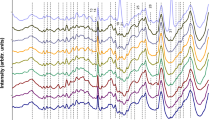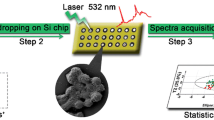Abstract
Lower respiratory tract infections are the fourth leading cause of death worldwide. Here, a timely identification of the causing pathogens is crucial to the success of the treatment. Raman spectroscopy allows for quick identification of bacterial cells without the need for time-consuming cultivation steps, which is the current gold standard to detect pathogens. However, before Raman spectroscopy can be used to identify pathogens, they have to be isolated from the sample matrix, i.e., sputum in case of lower respiratory tract infections. In this study, we report an isolation protocol for single bacterial cells from sputum samples for Raman spectroscopic identification. Prior to the isolation, a liquefaction step using the proteolytic enzyme mixture Pronase E is required in order to deal with the high viscosity of sputum. The extraction of the bacteria was subsequently performed via different filtration and centrifugation steps, whereby isolation ratios between 46 and 57 % were achieved for sputa spiked with 6·107 to 6·104 CFU/mL of Staphylococcus aureus. The compatibility of such a liquefaction and isolation procedure towards a Raman spectroscopic classification was shown for five different model species, namely S. aureus, Staphylococcus epidermidis, Streptococcus pneumoniae, Klebsiella pneumoniae, and Pseudomonas aeruginosa. A classification of single-cell Raman spectra of these five species with an accuracy of 98.5 % could be achieved on the basis of a principal component analysis (PCA) followed by a linear discriminant analysis (LDA). These classification results could be validated with an independent test dataset, where 97.4 % of all spectra were identified correctly.

Development of an isolation protocol of bacterial cells out of sputum samples followed by Raman spectroscopic measurement and species identification using chemometrical models.




Similar content being viewed by others
References
Engel C, Brunkhorst F, Bone H-G, Brunkhorst R, Gerlach H, Grond S, Gruendling M, Huhle G, Jaschinski U, John S, Mayer K, Oppert M, Olthoff D, Quintel M, Ragaller M, Rossaint R, Stuber F, Weiler N, Welte T, Bogatsch H, Hartog C, Loeffler M, Reinhart K (2007) Epidemiology of sepsis in Germany: results from a national prospective multicenter study. Intensive Care Med 33(4):606–618
(WHO) WHO (2014) Global Health Estimates 2014. World Health Organization (WHO);. http://www.who.int/healthinfo/global_burden_disease/en/. Accessed 23.01.2015
Remington LT, Sligl WI (2014) Community-acquired pneumonia. Curr Opin Pulm Med 20(3):215–224
Barbier F, Andremont A, Wolff M, Bouadma L (2013) Hospital-acquired pneumonia and ventilator-associated pneumonia: recent advances in epidemiology and management. Curr Opin Pulm Med 19(3):216–228
Lung M, Codina G (2012) Molecular diagnosis in HAP/VAP. Curr Opin Crit Care 18(5):487–494
Bogaerts P, Hamels S, de Mendonca R, Huang T-D, Roisin S, Remacle J, Markine-Goriaynoff N, de Longueville F, Plüster W, Denis O, Glupczynski Y (2013) Analytical validation of a novel high multiplexing real-time PCR array for the identification of key pathogens causative of bacterial ventilator-associated pneumonia and their associated resistance genes. J Antimicrob Chemother 68(2):340–347
Endimiani A, Hujer KM, Hujer AM, Kurz S, Jacobs MR, Perlin DS, Bonomo RA (2011) Are we ready for novel detection methods to treat respiratory pathogens in hospital-acquired pneumonia? Clin Infect Dis 52(suppl 4):S373–S383
Wu D, Hou C, Li Y, Zhao Z, Liu J, Lu X, Shang X, Xin Y (2014) Analysis of the bacterial community in chronic obstructive pulmonary disease sputum samples by denaturing gradient gel electrophoresis and real-time PCR. BMC Pulm Med 14(1):179
Aydemir O, Aydemir Y, Ozdemir M (2014) The role of multiplex PCR test in identification of bacterial pathogens in lower respiratory tract infections. Pak J Med Sci 30(5):1011–1016
Kusić D, Kampe B, Rösch P, Popp J (2014) Identification of water pathogens by Raman microspectroscopy. Water Res 48:179–189
Stöckel S, Meisel S, Elschner M, Melzer F, Rösch P, Popp J (2015) Raman spectroscopic detection and identification of Burkholderia mallei and Burkholderia pseudomallei in feedstuff. Anal Bioanal Chem 407(4):787–794
Meisel S, Stöckel S, Rösch P, Popp J (2014) Identification of meat-associated pathogens via Raman microspectroscopy. Food Micorobiol 38:36–43
Kloß S, Kampe B, Sachse S, Rösch P, Straube E, Pfister W, Kiehntopf M, Popp J (2013) Culture independent Raman spectroscopic identification of urinary tract infection pathogens: a proof of principle study. Anal Chem 85(20):9610–9616
Harz M, Kiehntopf M, Stöckel S, Rösch P, Straube E, Deufel T, Popp J (2009) Direct analysis of clinical relevant single bacterial cells from cerebrospinal fluid during bacterial meningitis by means of micro-Raman spectroscopy. J Biophotonics 2(1-2):70–80
Kloß S, Rösch P, Pfister W, Kiehntopf M, Popp J (2015) Toward culture-free Raman spectroscopic identification of pathogens in ascitic fluid. Anal Chem 87(2):937–943
Krause M, Radt B, Rösch P, Popp J (2007) The investigation of single bacteria by means of fluorescence staining and Raman spectroscopy. J Raman Spectrosc 38(4):369–372
Krause M, Rösch P, Radt B, Popp J (2008) Localizing and identifying living bacteria in an abiotic environment by a combination of Raman and fluorescence microscopy. Anal Chem 80(22):8568–8575
Pahlow S, Kloß S, Blättel V, Kirsch K, Hübner U, Cialla D, Rösch P, Weber K, Popp J (2013) Isolation and enrichment of pathogens with a surface-modified aluminium chip for Raman spectroscopic applications. ChemPhysChem 14(15):3600–3605
Meisel S, Stöckel S, Elschner M, Rösch P, Popp J (2011) Assessment of two isolation techniques for bacteria in milk towards their compatibility with Raman spectroscopy. Analyst 136(23):4997–5005
Wu X, Chen J, Li X, Zhao Y, Zughaier SM (2014) Culture-free diagnostics of Pseudomonas aeruginosa infection by silver nanorod array based SERS from clinical sputum samples. Nanomedicine : Nanotechnol Biol Med 10(8):1863–1870
Bosch A, Miñán A, Vescina C, Degrossi J, Gatti B, Montanaro P, Messina M, Franco M, Vay C, Schmitt J, Naumann D, Yantorno O (2008) Fourier transform infrared spectroscopy for rapid identification of nonfermenting gram-negative bacteria isolated from sputum samples from cystic fibrosis patients. J Clin Microbiol 46(8):2535–2546
Rusciano G, Capriglione P, Pesce G, Abete P, Carnovale V, Sasso A (2013) Raman spectroscopy as a new tool for early detection of bacteria in patients with cystic fibrosis. Laser Phys Lett 10(7):075603
R Development Core Team (2011) R: A Language and Environment for Statistical Computing. R Foundation for Statistical Computing, Vienna, Austria
Bocklitz T, Walter A, Hartmann K, Rösch P, Popp J (2011) How to pre-process Raman spectra for reliable and stable models? Anal Chim Acta 704(1-2):47–56
Morhác M, Kliman J, Matoušek V, Veselský M, Turzo I (1997) Background elimination methods for multidimensional coincidence γ-ray spectra. Nucl Inst Methods Phys Res Sect A 401(1):113–132
Zhang D, Jallad KN, Ben-Amotz D (2001) Stripping of cosmic spike spectral artifacts using a new upper-bound spectrum algorithm. Appl Spectrosc 55(11):1523–1531
Dörfer T, Bocklitz T, Tarcea N, Schmitt M, Popp J (2011) Checking and improving calibration of Raman spectra using chemometric approaches. Z Phys Chem 225(6-7):753–764
Bocklitz T, Putsche M, Stüber C, Käs J, Niendorf A, Rösch P, Popp J (2009) A comprehensive study of classification methods for medical diagnosis. J Raman Spectrosc 40(12):1759–1765
Schmid U, Rösch P, Krause M, Harz M, Popp J, Baumann K (2009) Gaussian mixture discriminant analysis for the single-cell differentiation of bacteria using micro-Raman spectroscopy. Chemom Intell Lab Syst 96(2):159–171
Münchberg U, Rösch P, Bauer M, Popp J (2014) Raman spectroscopic identification of single bacterial cells under antibiotic influence. Anal Bioanal Chem 406(13):3041–3050
Schröder U-C, Ramoji A, Glaser U, Sachse S, Leiterer C, Csaki A, Hübner U, Fritzsche W, Pfister W, Bauer M, Popp J, Neugebauer U (2013) Combined dielectrophoresis—Raman setup for the classification of pathogens recovered from the urinary tract. Anal Chem 85(22):10717–10724
Stöckel S, Meisel S, Elschner M, Rösch P, Popp J (2012) Identification of Bacillus anthracis via Raman spectroscopy and chemometric approaches. Anal Chem 84(22):9873–9880
Stöckel S, Meisel S, Elschner M, Roesch P, Popp J (2012) Raman spectroscopic detection of anthrax endospores in powder samples. Angew Chem Int Ed 51(22):5339–5342, S5339/5331-S5339/5339
Breiman L (2001) Random forests. Mach Learn 45(1):5–32
Nicholas B, Djukanovic R (2009) Induced sputum: a window to lung pathology. Biochem Soc Trans 37(4):868–872
Rubin BK (2014) Secretion properties, clearance, and therapy in airway disease. Transl Respir Med 2:6
Campbell MJ (1970) Tetracycline levels in bronchial secretions. J Clin Pathol 23(5):427–434
Movasaghi Z, Rehman S, Rehman IU (2007) Raman spectroscopy of biological tissues. Appl Spectrosc Rev 42(5):493–541
Hedegaard M, Matthäus C, Hassing S, Krafft C, Diem M, Popp J (2011) Spectral unmixing and clustering algorithms for assessment of single cells by Raman microscopic imaging. Theor Chem Accounts 130(4-6):1249–1260
Harz M, Rösch P, Peschke KD, Ronneberger O, Burkhardt H, Popp J (2005) Micro-Raman spectroscopic identification of bacterial cells of the genus Staphylococcus and dependence on their cultivation conditions. Analyst 130(11):1543–1550
Lieberman D, Schlaeffer F, Boldur I, Horowitz S, Friedman MG, Leiononen M, Horovitz O, Manor E, Porath A (1996) Multiple pathogens in adult patients admitted with community-acquired pneumonia: a one year prospective study of 346 consecutive patients. Thorax 51(2):179–184
Acknowledgments
Funding of the research projects FastDiagnosis (13N11350) and “JBCI 2.0” (03IPT513Y—Unternehmen Region, InnoProfile Transfer) from the Federal Ministry of Education and Research, Germany (BMBF) and FastTB (2013FE9057) from Free State of Thuringia and the European Union (EFRE) are gratefully acknowledged. We thank Prof. Dr. Wolfgang Pfister from the Institute of Medical Microbiology (University Hospital Jena) for providing the used bacterial strains. The authors thank Bernd Kampe for the help with the program GnuR and Prof. Dr. Michael Schmitt, Dr. Susann Meisel, and Dr. Stephan Stöckel for the critical reading of the present manuscript.
Author information
Authors and Affiliations
Corresponding author
Additional information
Published in the topical collection Raman4Clinics with guest editors Jürgen Popp and Christoph Krafft.
Rights and permissions
About this article
Cite this article
Kloß, S., Lorenz, B., Dees, S. et al. Destruction-free procedure for the isolation of bacteria from sputum samples for Raman spectroscopic analysis. Anal Bioanal Chem 407, 8333–8341 (2015). https://doi.org/10.1007/s00216-015-8743-x
Received:
Revised:
Accepted:
Published:
Issue Date:
DOI: https://doi.org/10.1007/s00216-015-8743-x




